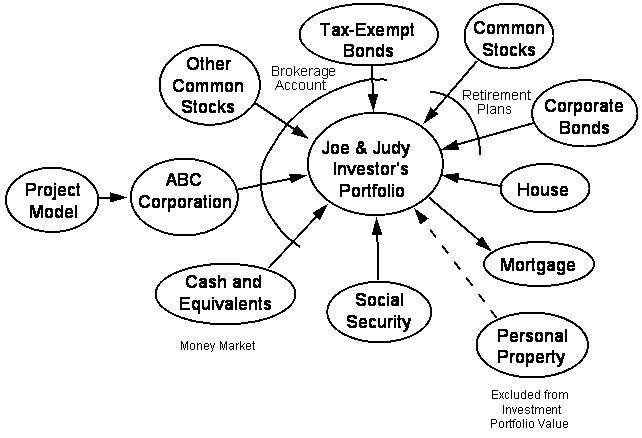
Go to the Prior Tip "Evolving
Inventions" by John Koza, Martin Keane and Matthew Streeter in Scientific
American
Go to the Next Tip "Risk,
Uncertainty and Investment Decision-Making in the Upstream Oil and Gas
Industry"
Return to MaxValue Home Page
Working on this paper and the underlying model consumed much of my time in late 2002 and early 2003. It builds upon earlier research in representing shareholder value. This has been one of the most intellectually-challenging projects of my career.
Many companies devote considerable attention and effort to portfolio optimization. Is this adding value for shareholders?
Continuing my earlier research, I endeavored to model a typical stock-investing couple, one of the companies in which they own stock, and one major project in the company. The figure illustrates the major elements. The models are now greatly improved (I think). They are written in Visual Basic, a much more rigorous and powerful development environment than the earlier QuickBasic used. This will provide a platform for continuing investigation.

I continue to believe the following equation should be true in a well-designed decision policy:
(Project Value) + (Company Value Without the Project) = (Company Value With the Project)
How the investor feels about risk and time value of money affect how he or she values cashflows from an investment. If everything is working in the model, incremental project value times the investor's share of the company should equal incremental value to the investor.
I added another fundamental equation: D Initial Portfolio Value = D Certainty Equivalent
For this to be true, according to my shareholder model, the investor would use an unusually-low present value (PV) discount rate. This is pleasantly similar to the finding of my prior 1995 paper. The rate would be comparable to that of a home mortgage, essentially a risk-free rate for the investor. However, I'm not fully convinced that this is correct: If you have any thoughts on the matter, please write or give me a call. |
Despite my ambition to tie everything together neatly into a unified evaluation theory, this research cycle resulted in more questions than answers. Here are some additional issues:
The formula for calculating the terminal value in the company model's cashflow projection is extremely important. I'm having trouble reconciling the discount rate that ought to be used to reflect the shareholder's decision policy versus the types of discount rates implied by current stock prices. The ideas in Dow 36,000 may be correct, but that's not the way people behave.
The model shows greater benefits than expected for portfolio diversification, de-coupling business units, and price hedging. I think this is because of tiny cashflow investments being reinvested for rest of the 20-year planning horizon. This needs further investigation.
What is the best way to determine decision policy for individual projects? We don't want to run the company portfolio model for every decision. I think the portfolio model would be used best for (a) for an occasional situational assessment, (b) for making very important decisions, and (c) for calibrating a decision policy for everyday decisions.
I never imagined that I would become so involved in finance theory. However, this is important. Slight changes in decision policy parameters can have a profound impact on the results of an evaluation. My learning continues.
—John Schuyler, June 2003.
Copyright © 2003 by John R. Schuyler. All rights reserved. Permission to copy with reproduction of this notice.